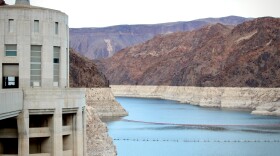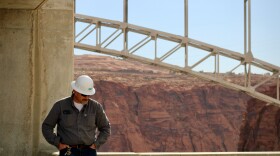Six of the seven states that use water from the Colorado River have agreed on a proposal to leave more water in Lake Mead, the nation’s largest reservoir. California, which has the largest and oldest water rights in the region, was the lone holdout.
The proposal was sent to the Bureau of Reclamation as the federal agency considers adjusting the amount of water released from Lake Mead and Lake Powell each year. Climate change has supercharged a 23-year drought, shrinking the reservoirs and threatening the functionality of the dams which hold them back. Reclamation solicited input from states as it continues to investigate ways to prop up those reservoirs, potentially resulting in painful cutbacks to some who use its water.
“I think the fact that six states are willing to issue this letter without California being on board shows the gravity of the situation for them,” said Sarah Porter, director of the Kyl Center for Water Policy at Arizona State University. “I'm sure they all would have preferred to have California be a cosigner of this, and it just shows how seriously they're all taking this.”
The six-state proposal, branded as the “Consensus-Based Modeling Alternative” would add about 1.5 million acre-feet to Lake Mead in each of the next two years. That’s roughly the same amount of water that is lost each year due to evaporation and inefficient infrastructure.
The plan attempts to correct an accounting problem. Each year, some water users in Nevada, Arizona and California are legally entitled to water in Lake Mead that does not physically exist, because it evaporates off of the reservoir’s surface before it ever has a chance to flow downstream. The total amount of evaporated water varies each year depending on reservoir levels and weather.
Accounting for that quantity of lost water could get the basin’s users closer to the needed conservation to slow the decline of water levels at Lake Mead. Without changes, federal scientists say the reservoir will continue dropping towards “minimum power pool,” the level at which hydropower generation within the Hoover Dam becomes impossible, and “deadpool,” the level at which water is too low to flow through the dam at all.
This proposal takes cues from a study drawn up last fall, in which the Southern Nevada Water Authority assessed the amount of water lost to evaporation and leaky canals in the river’s Lower Basin, which consists of Nevada, Arizona and California. That agency, which serves Las Vegas and the surrounding area, uses only about 2% of the river’s water, and stands to lose relatively little water if the plan is implemented.
Water users in Arizona and California stand to lose more water. The plan outlines a system in which reductions are larger for those further downstream. It divides the lower basin into five “reaches,” below Lake Powell.
California’s absence from this agreement hints at the state’s desire to lean on its more protected legal status on the river. Critics say the river’s foundational 1922 compact is ill-suited to meet the challenges posed by the changing climate and fast-growing region. It operates on a system of “prior appropriation” in which the oldest water rights are the last to be impacted by cutbacks during times of shortage. Southern California’s sprawling agricultural communities – largely in the Imperial and Coachella valleys – hold some of the river’s oldest rights. This has led some analysts to speculate that water-sharing issues will be tested in court if heavy cuts that defy the compact are imposed.
California released details of its own proposal to Reclamation late Tuesday. The state suggested the adoption of a water-saving plan it first outlined last October. Under that plan, the state would voluntarily cut back on its water use from the Colorado River use by 400,000 acre-feet – about 9% of its total annual use – each year until 2026.
In a press release, the state’s Colorado River board wrote that its proposal would reduce water use while “protecting infrastructure, prioritizing public health and safety, and upholding the existing body of laws, compacts, decrees, and agreements that govern Colorado River operations.”
California’s proposal emphasizes the state’s desire to follow existing legal structures for river management, and says further steps could be taken if water levels at Lake Mead dip below 1,000 feet above sea level.
The six-state plan is a rare example of agreement among all Upper Basin states and some Lower Basin states, as negotiations over how to share the river have historically been contentious. That the Lower Basin doesn’t account for evaporation from federally-operated reservoirs has been a long-standing complaint of Upper Basin users who say they cannot commit to further conservation until that’s fixed. Upper Basin users are already charged for evaporation from federally-managed water projects. Over the past decade, as climate change has shrunk supplies and forced an urgent need to scale back demand, states have been unable to find consensus around steep cuts to water use.

“Everybody's got to suck it up and figure it out,” said Felicia Marcus, a fellow at Stanford University’s Water in the West Program. “Frankly, you don't get to a deal unless people are really empathetic to all the other players’ legitimate interests. And history is an interest, the future is an interest, the present is an interest.”
Next, the Bureau of Reclamation will continue to mull the details of its Supplemental Environmental Impact Statement, a document that will outline any necessary tweaks to the amount of water released from Powell and Mead.
Analysts say the agency is unlikely to accept the six-state proposal on its face, especially since it is not a full seven-state consensus, but will probably include some of its details.
“This letter gives the Bureau a lot of guidance about what kind of response to expect from different approaches,” said Porter, of Arizona State University. “But because there's serious consensus around some major steps now, the bureau knows that these steps can be taken, and we know at least that chances are there will be a degree of cooperation with those steps.”
The Bureau of Reclamation’s notice announcing the potential changes to reservoir operations said the draft supplemental EIS would be released in spring 2023, with a final decision in late summer 2023.
Reclamation has explained that it needs 2-4 million acre-feet of water conservation to adequately protect the dams. That quantity was the subject of an unprecedented request last summer, when the agency asked states to conserve water before the end of a two-month window. The federal government took new action when states were unable to come to an agreement before the deadline. This proposal, although remarkable for bringing six states together, falls short of the amount of water conservation Reclamation says it needs.
Conservation groups say cutbacks similar to those outlined in the six-state proposal could reduce flows downstream of Lake Mead, limiting the amount of water in habitats for native fish and other species.
Even 2-4 million acre-feet of conservation would not be nearly enough to rescue the Colorado River basin from peril. Critics and negotiators alike characterize recent water conservation efforts as temporary. Any new conservation measures announced by Reclamation would likely join a patchwork of band-aids designed to keep the Colorado River system running normally until 2026, when current guidelines for the river expire, and states are expected to draw up a more drastic, permanent rework of rules for sharing its water.
This story is part of ongoing coverage of the Colorado River, produced by KUNC and supported by the Walton Family Foundation.










